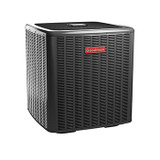What Is The Difference: AC Compressor vs. Condenser
Because their names are similar and their functions are pretty close, even seasoned HVAC technicians will sometimes confuse the terms compressor and condenser. That being said, best practice definitions do divide them into two entirely separate terms. An air conditioner’s compressor consists of a mechanical module that’s designed to reduce the amount of gas in a system to increase the pressure. When you squeeze more gas through a smaller space, the pressure goes way up.
AC condensers take pressurized gas out of the compressor and change it into a liquid-vapor. Both of these components are extremely important, though the jobs that they do are pretty distinct.
Defining The Job Of An AC Compressor
Whenever the volume of a gas decreases but the total quantity of gas remains the same, the overall pressure increases. You’re able to hold much more air at 200 bar than you ever could at say 100 bar.
That increase in pressure is needed to adjust the temperature of the air circulating through the system, which is how an air conditioner allows cooler air to flow into the ductwork. If you have ever used a gas duster that suddenly got cold, then you’ve witnessed this first hand. This same principle powers the air conditioning compressors that in turn power AC units of all sizes.
Conversely, in any system involving heat transfer in either direction, condensers are functionally exchangers. They can condense a substance back into a liquid. The latent heat left in the fluid is released by it and transferred out into the surrounding environment.

You may have worked with some types of industrial equipment that use condensers as a form of heat rejection. They can be made in several different sizes, which has allowed engineers to build various form factors of equipment. Anything from a small window unit or portable system is possible up to the giant methods used to cool facility-wide operations.
Over the years, compressors have been designed to a wide variety of specifications. The underlying operating principle has always been the same. They’re always made to take gas from an area of lower pressure and, by constricting the amount of surface area involved, shove it into one of tremendous pressure. Though it might be a bit unfortunate that their names are somewhat close, it’s helpful to keep these functional distinctions in mind.
Distinguishing The Two Components
While their names are often confusing, they have significant differences. Condenser coils are visually distinctive and are probably one of the most famous parts attached to a refrigeration unit, so it’s tough to miss them.
Evaluate Your HVAC Systems WIth Furnace Part Source
At Furnace Part Source, we do our best to provide support for all modules regardless of their function. Our stock has both the newest components for air conditioning systems and those from
Finding the right kind of replacement parts is also a challenge, though, so make sure to contact us online for more information about the best options for you if you need to replace the condensers or compressors for a particular piece of equipment.
Recent Posts
-
Trane Central Air System Not Cooling
Struggling with a Trane central air system that won’t cool your home? You’re not alone. In this deta …27th Jun 2024 -
Lennox Central Air System Not Cooling
When your Lennox central air system stops cooling, it not only disrupts your comfort but can also si …27th Jun 2024 -
Goodman Central Air System Not Cooling
When your Goodman central air system is not cooling, it can be frustrating and uncomfortable, especi …20th Jun 2024





